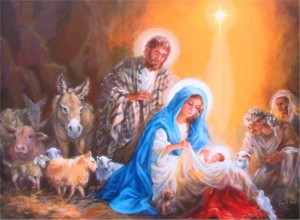About Those Christmas Animals
 The Classic manger scenes always include cows (or oxen), donkeys (or mules), and sheep.
The Classic manger scenes always include cows (or oxen), donkeys (or mules), and sheep.
The Egyptian god Apis was a bull who was believed to be a king and who would become a god after his ritual slaughter. The Roman god Consus was a protector of grain, who had an altar underground, and who considered mules to be sacred animals. The Egyptian god Amun Ra was a male sheep who created himself, and was seen as the champion of the poor and personal piety. He was such a powerful god in Egypt that everyone who prayed to him had to first confess their sins. A recorded prayer to Amun from that time period is: “You are Amun, the Lord of the silent, who comes at the voice of the poor; when I call to you in my distress You come and rescue me….Though the servant was disposed to do evil, the Lord is disposed to forgive. The Lord of Thebes spends not a whole day in anger; His wrath passes in a moment; none remains. His breath comes back to us in mercy.”
So, what’s the point? Well, it would seem that these “gods” who represented
- a slaughtered king
- a lamb that created himself and towhom people confessed their sins and who is full of mercy while championing the poor
- who is the protector of grain whose altar was buried underground
are all present in the Christmas scene.
They are all present to worship
- the REAL King to be sacrificed
- the REAL Lamb of God who is merciful and loves the poor and to whom we confess our sins
- the REAL God who was buried underground and who gives us our daily grain in the form of the Eucharist
Only Our Father in Heaven would have foreseen all of this irony, and made it present to us! Thanks to St. Francis for creating the first living manger scene!

